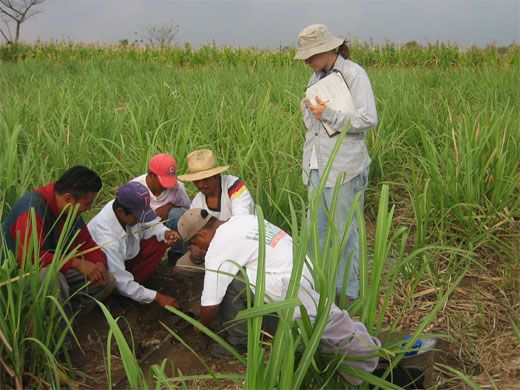Down to Earth
Anthropologist Amber VanDerwarker is unraveling the mysteries of the ancient Olmec by figuring out what they ate
/https://tf-cmsv2-smithsonianmag-media.s3.amazonaws.com/filer/yi-vanderwarker-631.jpg)
Starting around 1200 B.C., in southern Mexico, the Olmec created what most scholars agree was the first New World civilization, building large cities with monumental architecture, carving reliefs of animal gods, and trading raw materials and finished goods across hundreds of miles. The later Maya and Aztec left behind copious evidence of their culture in the form of monuments, paintings and engraved writings. But few clues about Olmec society, which collapsed around 400 B.C., have survived in the damp lowlands along the Gulf of Mexico.
That's why Amber VanDerwarker is bent at her microscope, poring over 3,000-year-old fish bones and burned plant matter. A 33-year-old anthropologist at the University of California at Santa Barbara, she is sifting through the meagerest traces of the Olmec's world to focus on what ordinary people planted, hunted and ate—intriguing new evidence of how, when and why civilization emerged in the New World. Unlike her predecessors, who focused on dramatic but mysterious remains such as the massive stone heads made by the Olmec in their major cities, she believes that the best way to understand this ancient civilization is to carefully examine the mundane habits of those who lived outside the bustling cities.
"She is part of a new guard that is beginning to ask more fundamental questions about how people lived in the past," says colleague Philip Arnold of Loyola University in Chicago. "Amber offers a perspective that was clearly missing—a focus on the day-to-day activities of people."
VanDerwarker has long had a knack for the telling detail. Growing up mostly in Virginia—her father was an Air Force technician, her mother a bookkeeper—Amber wanted to be a novelist. She still writes poetry on the side. At the University of Oklahoma, she changed career tracks after taking a course in cultural anthropology. Conducting fieldwork at Cahokia in Illinois, the largest site associated with the Mound Builders of North America, she saw that though it offered little in the way of dramatic artifacts, the site was rich in the remains of daily life. Between 1999 and 2002, while she was a graduate student at the University of North Carolina at Chapel Hill, she examined plant and bone remains that Arnold and another archaeologist uncovered from two small sites in the volcanic Tuxtla region that was on the outskirts of Olmec territory but north of the city centers. "I hit pay dirt," VanDerwarker recalls.
What they found suggests that the Olmecs differed from early peoples in Egypt, Mesopotamia and China, where the growth of urban centers was closely tied to a single grain—wheat, barley and rice, respectively—and central powers coordinated vast networks of fields and farmers. Most researchers had assumed that it was the cultivation of maize that made the Olmec prosper.
On the contrary, say VanDerwarker and her colleagues, who identified an astonishing array of foods in the Olmec diet—from deer, ocelots, rabbits and turtles to beans, avocados and tree fruits. For several centuries, because the Olmec lived with what she calls "an abundance of resources," they even managed plots of fruit trees. Animals drawn to such forest gardens would have been easy to hunt. (The Olmecs focused on maize cultivation only in their civilization's later years.)
In her recent book, Farming, Hunting, and Fishing in the Olmec World, VanDerwarker provides solid data to back up the contention that the Olmec were pursuing a way of life radically different from the first civilizations in Africa and Asia. But she is not without her critics. Some scholars of Mesoamerica, noting that VanDerwarker's work is mostly in the Olmec hinterlands, say it sheds little light on how those nearer the culture's core lived. VanDerwarker responds that "understanding past societies does not mean just looking at the elites, at pretty monuments, at temples and altars." For her, the key to the Olmec is how they lived in villages and hamlets far from cities. "We certainly can't understand our own society," she says, "by narrowing our focus to Donald Trump or Paris Hilton."
Andrew Lawler has written about the archaeology of Iran, Iraq, Petra, Alexandria and Werowocomoco for Smithsonian.

/https://tf-cmsv2-smithsonianmag-media.s3.amazonaws.com/accounts/headshot/andrew2.png)
/https://tf-cmsv2-smithsonianmag-media.s3.amazonaws.com/accounts/headshot/andrew2.png)